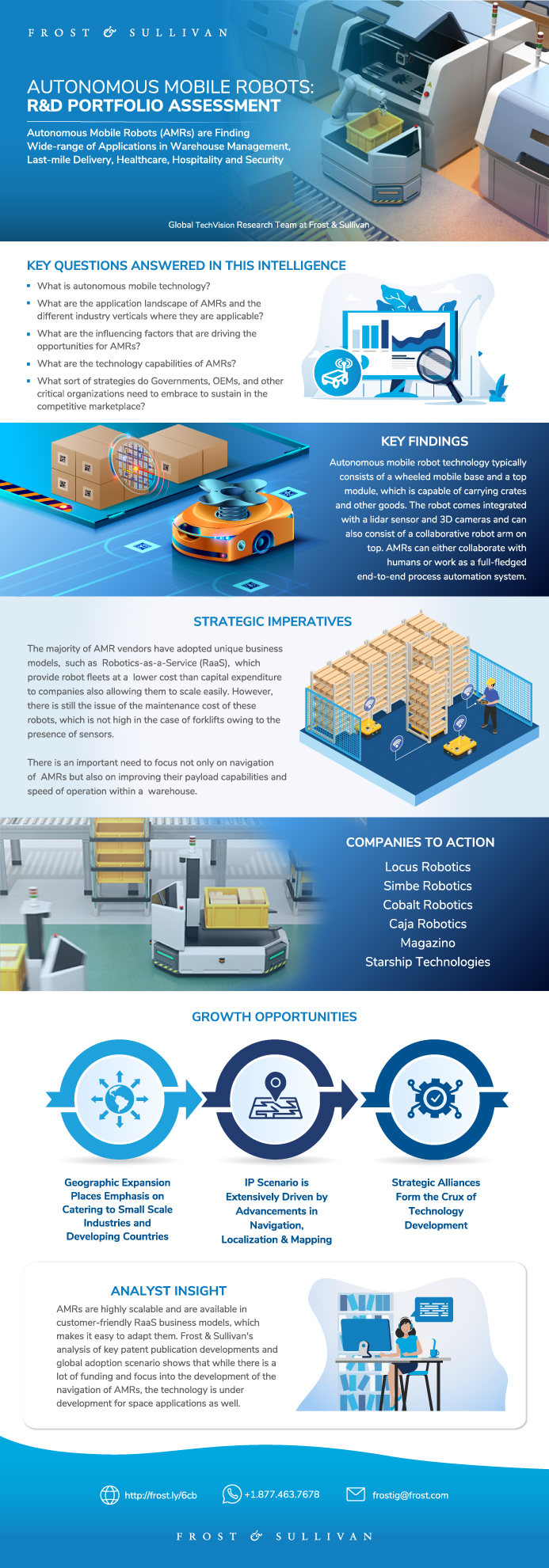Autonomous Mobile Robots: R&D Portfolio Assessment
Autonomous Mobile Robots: R&D Portfolio Assessment
Autonomous Mobile Robots are Finding Wide-range of Applications in Warehouse Management, Last-mile Delivery, Healthcare, Hospitality and Security
31-Mar-2021
Global
$4,950.00
Special Price $3,712.50 save 25 %
Description
The need for automation in logistics and warehouses is being driven by the increasing popularity of e-commerce which has experienced a further boost, same-day delivery demands, shortage of labor, and the time wasted by labor in travelling long distances and carrying out monotonous tasks and lastly the incapability to scale existing solutions such as conveyors or automated guided vehicles or forklifts to meet the customer demands.
Autonomous mobile robots (AMRs) have become widely popular not only in the field of e-commerce retail warehouses but have proven to have capabilities to collaborate with humans in different industries such as hospitality, healthcare, security, fashion, and third-party logistics. AMRs are highly scalable and are available in customer-friendly RaaS business models which makes it easy to adopt them.
Frost & Sullivan's analysis of key patent publication trends and global adoption scenario shows that while there is a lot of funding and focus into the development of the navigation of AMRs, the technology is under development for space applications as well.
Key Questions Answered in the Technology and Innovation Study
What is autonomous mobile technology?
What is the application landscape of AMRs and the different industry verticals where they are applicable?
What are the influencing factors that are driving the opportunities for AMRs?
What are the technology capabilities of AMRs?
Assessment of Industry Best Practices
IP and Funding Scenario
Growth Opportunities and Critical Success Factors
What sort of strategies do Governments, OEMs, and other critical organizations need to embrace to sustain in the competitive marketplace?
RESEARCH: INFOGRAPHIC
This infographic presents a brief overview of the research, and highlights the key topics discussed in it.Click image to view it in full size

Table of Contents
The Strategic Imperative 8™
The Strategic Imperative 8™
Strategic Imperatives for Autonomous Mobile Robots
About The Growth Pipeline Engine™
Growth Opportunities Fuel the Growth Pipeline Engine™
1.1 Scope of the Technology and Innovation Research
1.2 Research Methodology
1.3 Research Process and Methodology
1.4 Key Findings
2.1 Autonomous Mobile Robots – Technology Overview
2.2 Operation of Autonomous Mobile Robots with Top Modules
2.3 Application Areas of Autonomous Mobile Robots Across Different Industries
2.4 Key Applications of AMRs in Warehouses and Inventory Management
2.5 Accuracy and Interoperability are Key Trends Influencing Development and Adoption of AMRs
2.6 Autonomous Mobile Manipulation Robot is the Way Forward
2.7 AMMR – Stakeholder, Applications and Technology Overview
3.1 Use Case 1: Zalando, Germany and Magazino, Germany
3.2 Use Case 2: GEODIS, France and Locus Robotics, US
3.3 Use Case 3: Schnuck Markets, US and Simbe Robotics, US
4.1 Factors Influencing Technology Development and Adoption – Scalability and Flexibility are the Driving Force
4.2 Factors Influencing Technology Adoption- Limitation on Load Size Hinders Adoption
5.1 Strategic Partnerships Aim to Advance Autonomous Mobile Robots Technology
5.2 Strategic Alliances are Leading to the Development of Integrated Fulfillment Solutions
5.3 Mergers and Acquisitions Indicate both Hardware and Software for AMRs are being Acquired to Aid New Innovations
5.4 Space Autonomous Mobile Robots is the Most Active Area of Research
5.5 Research by NASA Enables Progress in the Development and Operation of Space AMR
5.6 Patent Assessment of AMRs – The US Leads in Patent Publication
5.7 Patent Filing Shows Potential Application for AMRs beyond Warehouse Management
5.8 Market Penetration and Strengthening R&D are Focus Areas for VC Investments in AMRs
6.1 Locus Robotics, US
6.2 Simbe Robotics, US
6.3 Autonomous Security Robot Performs Patrols to Detect Anomalies
6.4 Goods-to-Person Solution Enables Easy Warehouse Optimization and Management
6.5 Autonomous Mobile Robot Performs End-to-End Process Automation
6.6 Starship Technologies, US
7.1 Autonomous Robots Deployed for Disinfection in the COVID Era
7.2 Adoption of Disinfection Autonomous Robots Improves Safety of the Workplace
7.3 AMR can be Deployed to Kill Viruses such as COVID-19 in Hospitals
8.1 Growth Opportunity 1: Geographic Expansion Places Emphasis on Catering to Small Scale Industries and Developing Countries
8.2 Growth opportunity 1: Geographic Expansion Places Emphasis on Catering to Small Scale Industries and Developing Countries
8.3 Growth Opportunity 2: IP Scenario is Extensively Driven by Advancements in Navigation, Localization & Mapping
8.4 Growth Opportunity 2: IP Scenario is Extensively Driven by Advancements in Navigation, Localization & Mapping
8.5 Growth Opportunity 3: Strategic Alliances Form the Crux of Technology Development
8.6 Growth opportunity 3: Strategic Alliances Form the Crux of Technology Development
9.1 Key Contacts
Your Next Steps
Why Frost, Why Now?
Legal Disclaimer
Popular Topics
| No Index | No |
|---|---|
| Podcast | No |
| Author | Krithika Shekar |
| Industries | Cross Industries |
| WIP Number | D9F8-01-00-00-00 |
| Is Prebook | No |
 USD
USD GBP
GBP CNY
CNY EUR
EUR INR
INR JPY
JPY MYR
MYR ZAR
ZAR KRW
KRW THB
THB